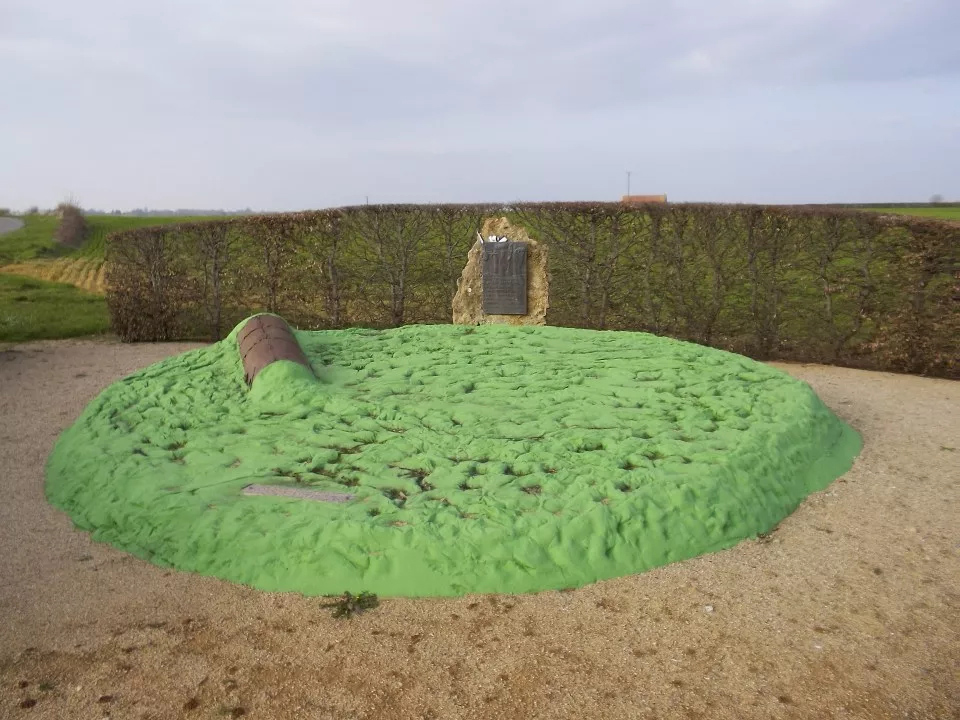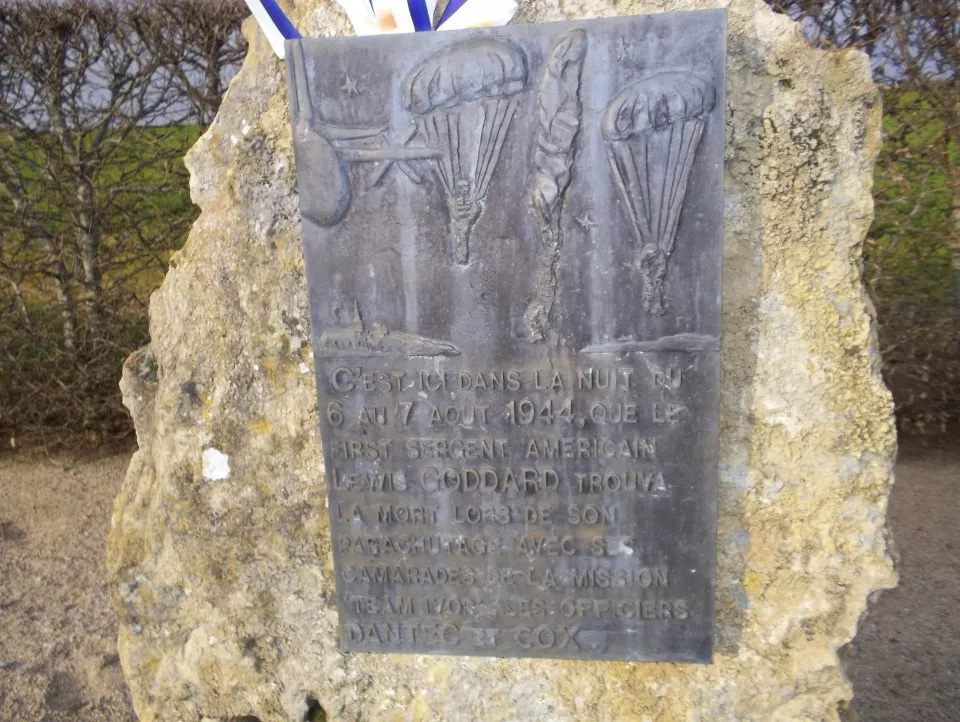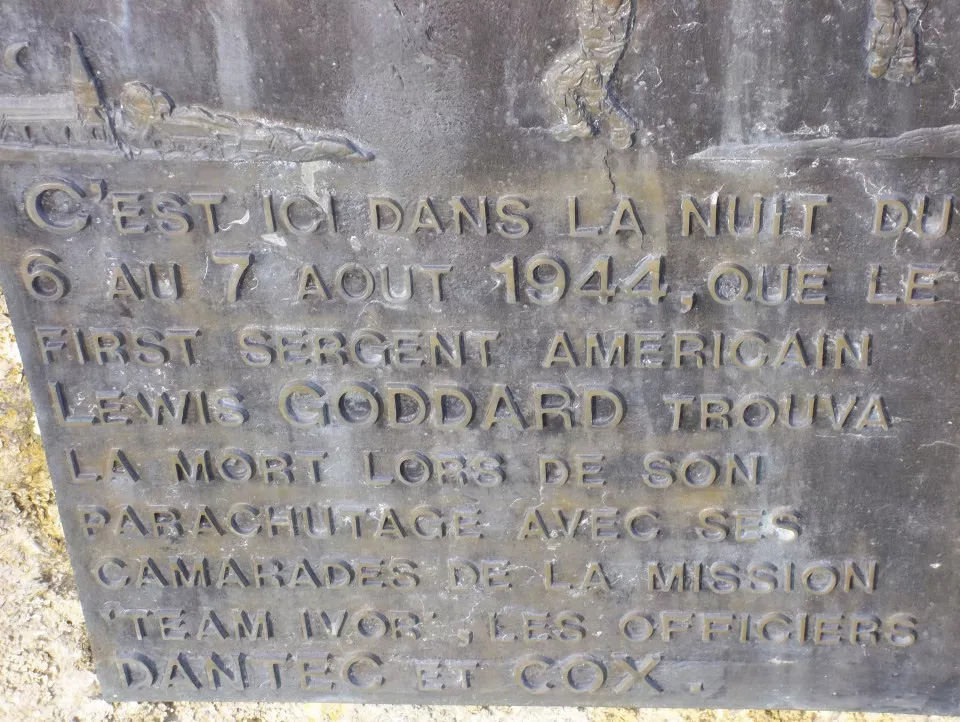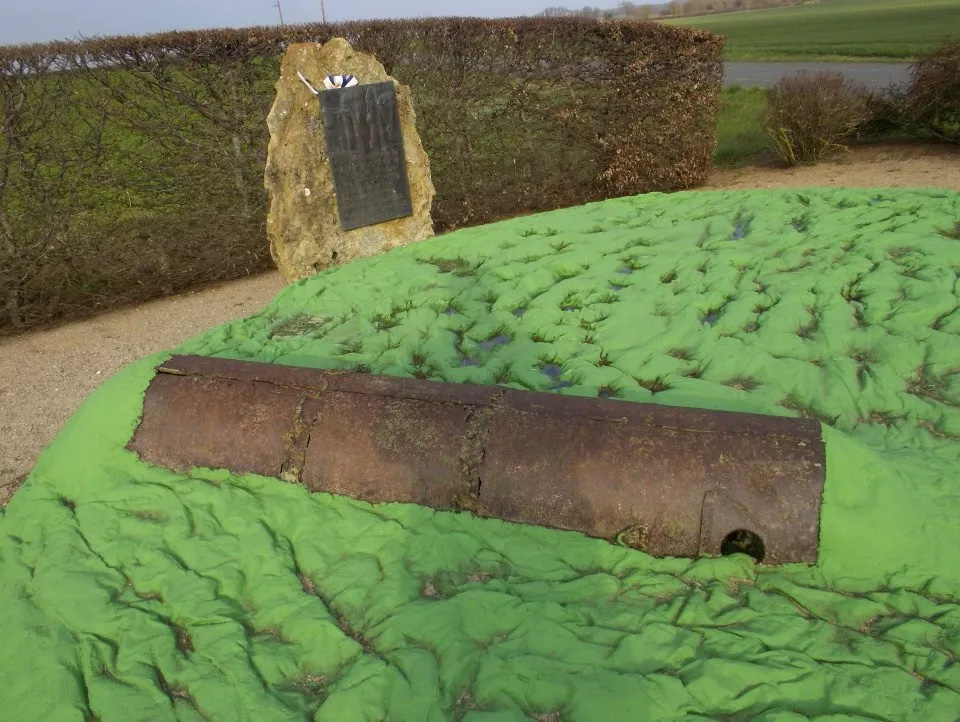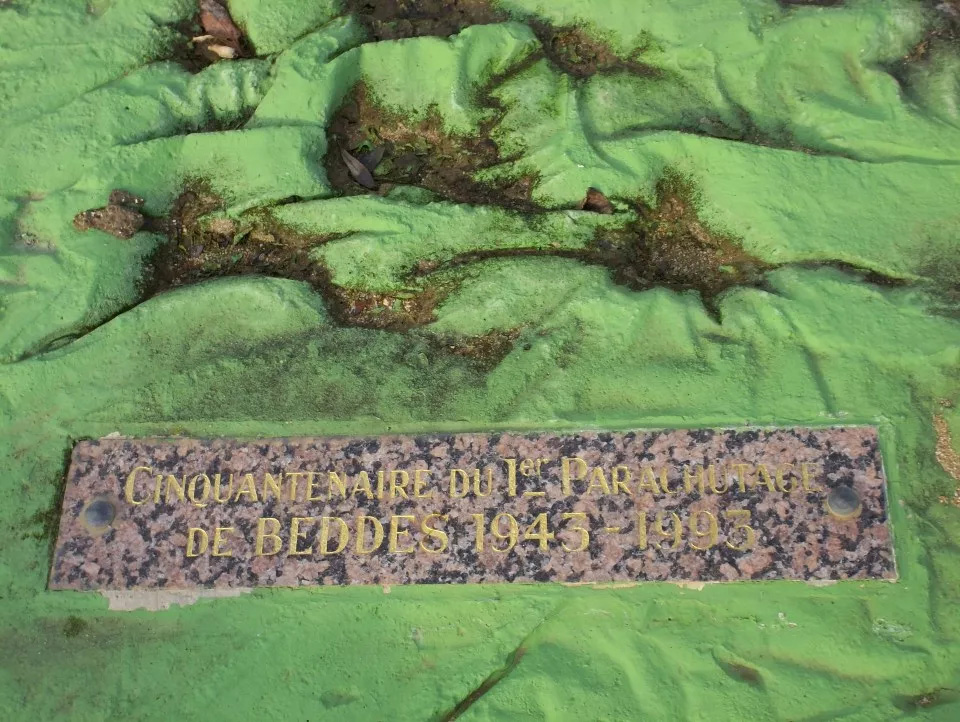1Sgt Lewis F. Goodard Memorial
Details:
On the east side of the crossroads.
A rough-hewn stone monument onto which a rectangular metal plaque is mounted. The plaque is inscribed with a French commemoration message in raised lettering. Above this, is an engraved depiction of the scene where three men are parachuting but the soldier’s chute in the middle is failing. In front of the stele is a circular green area where a container and another plaque are set onto. The plaque commemorates the 50th anniversary of the first parachute drop which took place in 1943 and the container was used during the parachute drop.
One of the first clandestine branches of the infant OSS (Office of Strategic Services), the predecessor of the CIA (Central Intelligence Agency), was an operation code-named Operation Jedburgh. Recruiters were sent out far and wide to ask for volunteers. Eventually, the elite group would number 92 teams with 276 men, 83 of them Americans. Each three-man team was made up of an American or British officer, a French officer, and an enlisted radio operator to maintain communications and coordinate with the central command back in Britain. The teams would parachute into German-occupied France and rendezvous with the Maquis and resupply them with arms, ammunition, food, and other supplies. Although they were told they were to be a top-secret group assigned to extremely dangerous missions, they recruited their quota of volunteers, Tec 3 Lewis Frelan Goddard among them.
After a rough trans-Atlantic crossing on the Queen Mary, the officers were sent to Scotland for further training and the enlisted radio operators went to Henley on the Thames for advanced radio training with their British counterparts. They then were sent to parachute school near Manchester where they were required to jump first from a balloon gondola and then make two jumps from an airplane, moving in a 'stick" of five or six men to the door from which they jumped. Each Jed carried an M-1 Carbine across his chest, a .45 pistol in his belt with extra clips of ammunition, a bag full of emergency rations, a first aid kit, a commando knife, and his binoculars. The teams jumped from low-flying planes at night to avoid detection and assembled at a pre-arranged area under the observation of the Maquis. Just before the men jumped, large metal containers of grenades, plastic explosives, submachine guns, radios, and boots - the paraphernalia of guerilla warfare - were pushed out of the plane ahead of them.
In June and July following the June 6 invasion, the Jedburghs were active as the Allied armies established a foothold and then moved through the almost impenetrable hedgerows of France to annihilate the German defenders. Team Ivor, a three-man team of British Capt. J.H. Cox, French Lt. R. Colin, and Sgt. L. F. Goddard was the first of three teams assigned to central France to organize the French resistance there and to screen the right or southern flank of Gen. George S. Patton's Third Army as it raced across France. They boarded their plane in England, flew over the Channel and Normandy, and approached the drop zone at a low level. The plane slowed, banked in a wide circle and the jumpmaster shoved out the weapon and equipment containers.
Unknown to the Jeds or the jumpmaster the chute and a static line of one of the containers did not detach and the heavy canister whipped back and forth on the side of the plane. The jumpmaster shouted `Action stations!' and Goddard prepared to jump. When ordered “Go,” he jumped at the very moment that the canister detached and flew across the back of the plane entangling itself in Goddard's parachute lines. Sgt. L. Frelan Goddard fell to his death on Aug. 7, 1944, at only 20 years of age. The team missed drop zone “Paris” near Beddes, landing in a nearby gravel pit.
According to Jedburgh team Hamish, team Ivor’s personnel left the aircraft after it had already passed the drop zone. This happened because the men and their containers exited the aircraft on the same pass, the men following the equipment. The drop zone was not long enough to accommodate men and containers on the same pass. Team Hamish also noted that drops should not occur under 600 feet, which may indicate that the aircraft was too low for the drop.
French villagers hid Sgt Goddard’s body from the German occupation forces until they could bury him with a proper service by their Maquis chaplain. Because the mission of the Jedburghs was top secret, the Goddard family received a notice from his Adjutant General on Aug. 21, reading ''Sgt. Goddard was performing duties that make it imperative that no publicity be given to his death. It is, therefore, requested that this information be divulged to no one outside of your immediate family." It was months until the Goddards received a communication from his comrade Capt. Cox learned the details of his death. Later, his body was exhumed and re-interred in the U.S. Military Cemetery at Draguignan, near Cannes, France, with about 800 others killed in action. He was awarded the Purple Heart posthumously.
Source of information: etvma.org, www.findagrave.com, cgsc.contentdm.oclc.org
Source of photos: www.aerosteles.net
Monument Text:
1st Plaque:
C'EST ICI DANS LA NUIT DU
6 AU 7 AOUT 1944, QUE LE
FIRST SERGENT AMERICAIN
LEWIS GODDARD TROUVA
LA MORT LORS DE SON
PARACHUTAGE AVEC SES
CAMARADES DE LA MISSION
'TEAM IVOR', LES OFFICIERS
DANTEC ET COX
English translation:
IT IS HERE ON THE NIGHT OF
AUGUST 6 TO 7, 1944, THE AMERICAN
FIRST AMERICAN SERGEANT
LEWIS GODDARD WAS FOUND
DEAD DURING HIS
PARACHUTING ALONG WITH HIS
COMRADES OF THE MISSION
'TEAM IVOR', THE OFFICERS
DANTEC AND COX
2nd Plaque:
CINQUANTENAIRE DU 1er PARACHUTAGE
DE BEDDES 1943 - 1993
English translation:
FIFTIETH ANNIVERSARY OF THE FIRST PARACHUTE DROP
OF BEDDES 1943 - 1993
Commemorates:
People:
Units:
Office of Strategic Services (OSS)
OSS
OSS- French Operational Group
Wars:
WWII
Other images :

